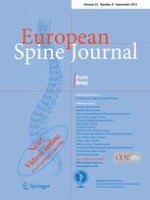Published in:

01-09-2013 | Original Article
Spinal alignment in low back pain patients and age-related side effects: a multivariate cross-sectional analysis of video rasterstereography back shape reconstruction data
Authors:
J. Schroeder, H. Schaar, K. Mattes
Published in:
European Spine Journal
|
Issue 9/2013
Login to get access
Abstract
Purpose
Spinal form in the sagittal plane and asymmetries of spinal alignment in the frontal plane were identified earlier to be associated with low back pain. This study was aiming at investigating whether age was influencing the significance of these findings.
Methods
Spinal alignment of 155 older and 58 younger low back pain patients was investigated using non-invasive video rasterstereography and compared to 192 pain free controls. Trunk inclination and imbalance, pelvis tilt and torsion, and the thoracic kyphosis and lumbar lordosis angle served as dependent variables, which were analyzed using multivariate procedures.
Results
Frontal plane parameters—trunk imbalance (λ > 0.60) in combination with pelvis tilt (λ > 0.64)—constituted an independent component in a factor analysis model of spine shape parameters in younger and older patients, but not in pain free controls. Trunk imbalance (frontal), trunk inclination (sagittal) and partially thoracic kyphosis angle (sagittal) were extracted to separate patients from controls (discriminant coefficients >0.50). Age could not be excluded as interfering variable for the lumbar lordosis angle. Significant univariate analyses revealed higher effect sizes for trunk imbalance and inclination (η
2 > 0.07) than for lordosis, kyphosis or pelvic parameters (η
2 < 0.06).
Conclusions
In line with corresponding findings trunk imbalance remained a low back pain-associated parameter not depending on age. Over all, sagittal trunk inclination and the thoracic kyphosis angle could not be established as being completely free from age influences, while the lumbar lordosis angle played a minor role and seemed to be influenced more by age than by low back pain in this rasterstereography study.





